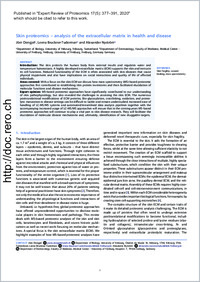Skin proteomics – analysis of the extracellular matrix in health and disease
- Dengjel, Jörn Department of Biology, University of Fribourg , Fribourg, Switzerland
- Bruckner-Tuderman, Leena Department of Dermatology, Faculty of Medicine, Medical Center - University of Freiburg , Freiburg, University of Freiburg, Freiburg, Germany Germany
- Nyström, Alexander Department of Dermatology, Faculty of Medicine, Medical Center - University of Freiburg , Freiburg, University of Freiburg, Freiburg, Germany Germany
-
03.05.2020
Published in:
- Expert Review of Proteomics. - 2020, vol. 17, no. 5, p. 377–391
English
Introduction The skin protects the human body from external insults and regulates water and temperature homeostasis. A highly developed extracellular matrix (ECM) supports the skin and instructs its cell functions. Reduced functionality of the ECM is often associated with skin diseases that cause physical impairment and also have implications on social interactions and quality of life of affected individuals. Areas covered With a focus on the skin ECM we discuss how mass spectrometry (MS)- based proteomic approaches first contributed to establishing skin protein inventories and then facilitated elucidation of molecular functions and disease mechanisms. Expert opinion MS-based proteomic approaches have significantly contributed to our understanding of skin pathophysiology, but also revealed the challenges in assessing the skin ECM. The numerous posttranslational modifications of ECM proteins, like glycosylation, crosslinking, oxidation, and proteolytic maturation in disease settings can be difficult to tackle and remain understudied. Increased ease of handling of LC- MS/MS systems and automated/streamlined data analysis pipelines together with the accompanying increased usage of LC-MS/MS approaches will ensure that in the coming years MS-based proteomic approaches will continue to play a vital part in skin disease research. They will facilitate the elucidation of molecular disease mechanisms and, ultimately, identification of new druggable targets.
- Faculty
- Faculté des sciences et de médecine
- Department
- Département de Biologie
- Language
-
- English
- Classification
- Biological sciences
- License
-
License undefined
- Identifiers
-
- RERO DOC 329886
- DOI 10.1080/14789450.2020.1773261
- Persistent URL
- https://folia.unifr.ch/unifr/documents/308990
Statistics
Document views: 119
File downloads:
- pdf: 417
